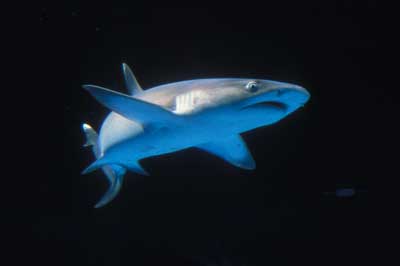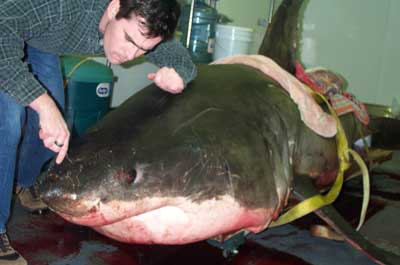A Shark's Sixth Sense
California Academy of Sciencies
Using the small, pore-shaped canals that pepper their snouts and heads, sharks can detect electricity.
Their reputation may hinge on their jaws, but when it comes to setting records in the animal world, it's not their relative jaw strength that tops the charts - it's their ability to detect electric fields. In fact, sharks are almost as precise as the best physics laboratories in the country when it comes to sensing tiny electric effects. They can use this "sixth sense" to find food and even mates, since all living animals create their own electric fields. When a fish swims, or even moves its gills, it creates a change in the surrounding electric field that sharks can detect with the hundreds of electrically sensitive, gel-filled canals around their heads.
While the electrosensory ability of sharks and their relatives has been well-documented, many questions remain about the way this system functions. Over the past several years, Brandon Brown from the University of San Francisco has brought the tools and ideas of physics to the study of the shark's sensory world. Most recently, he has focused on the clear, stiff gel that fills the shark's electrically sensitive canals. Whenever a shark at the Academy's Steinhart Aquarium or the Pelagic Shark Research Foundation dies, Brown and his colleagues extract some of its gel and test it for electricity and temperature sensitivity. He has found that the gel acts like a thermostat, helping the shark to detect minute temperature changes - such as those given off by potential prey - by turning them into electric signals.
 |
| Like other sharks, white-tipped reef sharks in the Steinhart Aquarium use electric signals to find food and even mates. Photo credit: Dong Lin, CAS. |
|
 |
| Brown extracts electro-sensitive gel from the snout of a Great White shark at the Pelagic Shark Research Foundation in Santa Cruz. Photo credit: Douglas Kellogg. |
 |
| Black-tipped and white-tipped reef sharks in the Steinhart Aquarium Photo credit: Dong Lin, CAS. |
Web Links
Shark Bibliography
http://www.calacademy.org/research/library/biodiv/biblio/shark2001.htm
http://www.calacademy.org/research/library/biodiv/biblio/sharkkid.htm
Brandon Brown
http://artsci.usfca.edu/servlet/ShowEmployee?empID=24&deptID=6
http://www.usfca.edu/physics/faculty/brown/bbresearch.html
http://www.usfca.edu/usfnews/03.04.03/fp4.html |

